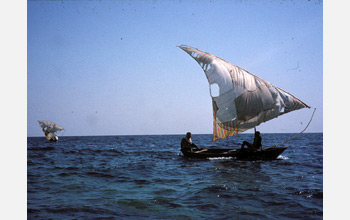Lake's surface waters are warmest on record
 |
Lake Tanganyika, the second-oldest and second-deepest lake in the world, could be in for some rough waters.
Geologists have determined that the East African rift lake has experienced unprecedented warming during the last century; its surface waters are the warmest on record.
That finding is important, the scientists state in this week's on-line issue of the journal Nature Geoscience, because the warm surface waters likely will affect fish stocks upon which millions of people in the region depend.
"This result is in addition to those from other African lakes showing that changes in regional climate have a significant impact on the lakes, and on the human populations that depend on the lakes' resources," said Paul Filmer, program director in the National Science Foundation (NSF)'s Division of Earth Sciences, which funded the research.
The scientists took core samples from the lakebed that laid out a 1,500-year history of the lake's surface temperature.
The resulting data showed that the lake's surface temperature, 26 °C (78.8 °F), last measured in 2003, is the warmest the lake has been for a millennium and a half.
The team also documented that Lake Tanganyika experienced its largest temperature change in the 20th century. The change has affected its unique ecosystem, which relies upon nutrients from the depths to jumpstart the food chain on which fish survive.
"Our data show a consistent relationship between lake surface temperature and productivity such as that of fish stocks," said Jessica Tierney of Brown University, the paper's lead author. "As the lake gets warmer, we expect productivity to decline, and we expect that it will affect the fishing industry."
Cores were taken in 2001 by Andrew Cohen, a geologist at the University of Arizona, and in 2004 by James Russell, a geologist at Brown University.
Lake Tanganyika is bordered by Burundi, the Democratic Republic of Congo, Tanzania, and Zambia--four of the poorest countries in the world.
An estimated 10 million people live near the lake, and depend on it for drinking water and for food.
Fishing is a crucial component of their diets and livelihoods: up to 200,000 tons of sardines and four other fish species are harvested annually from Lake Tanganyika.
The lake, one of the richest freshwater ecosystems in the world, is divided into two levels. Most of the animal species live in the upper 100 meters, including valuable sardines.
Below that, the lake holds less and less oxygen, and at certain depths, it has no oxygen.
The lake depends on wind to churn its waters and send nutrients from the depths toward the surface. These nutrients are food for algae, which supports the lake's entire food web.
But as Lake Tanganyika warms, the mixing of waters is lessened; fewer nutrients are funneled from the depths to the surface.
More warming at the surface magnifies the difference between the two lake levels; even more wind is needed to churn the waters enough to ferry nutrients toward the upper layer.
The researchers' data show that during the last 1,500 years, intervals of prolonged warming and cooling are linked with low and high algal productivity, respectively, indicating a clear link between past temperature changes and biological productivity in the lake.
"People throughout south-central Africa depend on the fish from Lake Tanganyika as a crucial source of protein," Cohen said. "This resource is likely threatened by the lake's unprecedented warming and the associated loss of lake productivity."
Climate change models show a general warming trend in the region, which would cause even greater warming of Lake Tanganyika's surface waters.
Some researchers believe that the declining fish stocks in Lake Tanganyika can be attributed mainly to overfishing, and Tierney and Russell say that may be a reason.
But they note that the warming in the lake, and the lessened mixing of critical nutrients, is exacerbating the fish stocks' decline, if not causing it.
"It's almost impossible for it not to be," Russell said.
Richard Lewis, Brown University (401) 863-3766 richard_lewis@brown.edu
The National Science Foundation (NSF) is an independent federal agency that supports fundamental research and education across all fields of science and engineering. In fiscal year (FY) 2010, its budget is about $6.9 billion. NSF funds reach all 50 states through grants to nearly 2,000 universities and institutions. Each year, NSF receives over 45,000 competitive requests for funding, and makes over 11,500 new funding awards. NSF also awards over $400 million in professional and service contracts yearly.
Link: http://www.nsf.gov/news/news_summ.jsp?cntn_id=116956&WT.mc_id=USNSF_51&WT.mc_ev=click
